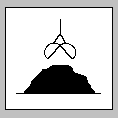| Soybeans | [German version] |
Table of contents |
|
| General: | ||
| Product information | ||
| Packaging | ||
| Transport | ||
| Container transport | ||
| Cargo securing | ||
Product information
Product name
| German | Sojabohnen |
| English | Soybeans |
| French | Graines de Soja |
| Spanish | Habas de Soja |
| Scientific | Glycine max. |
| CN/HS number * | 1201 00 ff. |
(* EU Combined Nomenclature/Harmonized System)
Product description
Soybeans are cherry-sized seeds of legumes (Leguminosae), one pod containing 1 – 3 differently shaped (round, oval, spherical, kidney-shaped) seeds rich in fat, protein, vitamins and lecithin. They came originally from China and only became more widespread in Europe and America from the end of the 18th century.
Soybeans are most often yellow in color, but many varieties also have black beans. Varieties are also known which have brown, olive-green and spotted beans. The hilum may be colorless, brown or black, while the cotyledons are yellow or green.
These days, soybeans constitute one of the world’s most economically significant plants and are cultivated and harvested on a grand scale. They belong to the category of oil-bearing seeds/fruits which, like the various types of cereal, are vegetable products with a low water content. However, they differ from grain in their high oil content, which may vary within broad limits.
The oil builds up in the seeds as a nutrient reserve and is stored in fine droplets in the seed or fruit flesh. Fat decomposition in oil-bearing seeds/fruits may lead to the risk of self-heating and cargo fires.
Oil content: 13 – 24% [1]
Quality / Duration of storage
Fully matured soybeans may be kept for a virtually unlimited time after drying.
With a water content of 8%, soybeans have a very good storage life and are thus also well suited to being transported for relatively long periods and in bulk.
Shipping is possible all year round, but should be as soon as possible after harvest, in order to avoid transporting excessively old goods. The year of harvest should therefore be ascertained before loading is begun.
Intended use
Soybeans are used to produce soy meal (as concentrated protein for livestock feed), soy oil, soy protein, soy coagulates (e.g. tofu), soy sauces.
Due to its high protein content of 38 – 41%, in Asia soy milk obtained from ground beans replaces all milk products. The residues serve as livestock feed, while the soy milk is also further processed into coagulates.
Figures
(Click on the Figures to enlarge them.)
 Figure 1 |
 Figure 2 |
 Figure 3 |
 Figure 4 |
 Figure 5 |
 Figure 6 |
Countries of origin
This Table shows only a selection of the most important countries of origin and should not be thought of as exhaustive.
| Europe | Southern Europe |
| Africa | |
| Asia | China, Japan |
| America | USA, Brazil, Argentina |
| Australia |
Back to beginning
Packaging
Soybeans are generally transported as bulk cargo but occasionally also as break-bulk cargo in bags of woven natural materials (e.g. jute) or woven plastic bags.
| Marking of packages | ||
 Keep dry |
 Use no hooks |
 Keep away from heat (solar radiation) |
Back to beginning
Transport
Symbols
 General cargo |
 Bulk cargo |
Means of transport
Ship, truck, railroad
Container transport
Ventilated containers (coffee containers), if the water content of the goods is < 8% and the lower limits set for the water content of packaging and container flooring and the oil content of the goods are complied with.
Cargo handling
In damp weather (rain, snow), the cargo must be protected from moisture, since it may lead to mold, spoilage and self-heating as a result of increased respiratory activity.
Hooks must not be used in handling bagged goods as they subject the cargo to point loads, so damaging the bags. Due to their shape, plate or bag hooks apply an area load and are thus more suitable for handling bags.
Stowage factor
| 1.53 – 1.67 m³/t (flat bags of jute fabric) [1] | |
| 1.39 – 1.48 m³/t (bags from Far East) [11] | |
| 1.81 m³/t (bags from West Africa) [11] | |
| 1.59 – 1.62 m³/t (bags, US gulf states) [11] | |
| 1.23 – 1.28 m³/t (bulk) [11] | |
| 1.35 – 1.39 m³/t (bulk, US gulf states) [11] | |
| 1.33 – 1.61 m³/t (bulk) [14] |
Stowage space requirements
Cool, dry, good ventilation
Segregation
Fiber rope, thin fiber nets
Cargo securing
Bagged cargo must be stowed and secured in the means of transport in such a manner that it cannot slip or shift during transport. If loss of volume and degradation of quality are to be avoided, the packages must not be damaged by other articles or items of cargo.
In the case of maritime transport of bulk cargo, the IMO (International Maritime Organization) „Code of Safe Practice for Solid Bulk Cargoes“ must be complied with.
Back to beginning
Risk factors and loss prevention
RF Temperature
Soybeans require particular temperature, humidity/moisture and ventilation conditions (SC VII) (storage climate conditions).
Favorable travel temperature range: 5 – 25°C [1]
Temperatures > 30°C should not prevail for an extended period, as such temperatures promote respiration of the cargo and may cause self-heating. The cargo should not be stowed near sources of heat and particularly not above heated double bottom tanks.
Back to beginning
RF Humidity/Moisture
Soybeans require particular temperature, humidity/moisture and ventilation conditions (SC VII) (storage climate conditions).
| Designation | Humidity/water content | Source |
| Relative humidity | 70% | [1] |
| Water content | 8 – 10% | [1] |
| 11 – 14% | [2] | |
| max. 13% | [3] | |
| max. 10% | [9] | |
| Maximum equilibrium moisture content | 65% | [1] |
Soybeans must be protected from all forms of moisture (seawater, rain and condensation water), since moisture promotes hydrolytic/enzymatic fat cleavage, which then results in self-heating due to increased respiration.
It may be seen from the sorption isotherm for soybeans that the critical water content is 13%, at which level the mold growth threshold of 75% is reached as the equilibrium moisture content.
 Figure 7 |
Problems of moisture may be prevented by suitable pre-drying. This is the easiest way of reducing the activity (respiration) of the beans and removing the nutrient medium for mold development and spoilage processes.
Bags with darkly shaded areas indicate insufficient drying prior to transport. However, they may also be a consequence of inadequate ventilation.
Back to beginning
RF Ventilation
Soybeans require particular temperature, humidity/moisture and ventilation conditions (SC VII) (storage climate conditions).
Recommended ventilation conditions: air exchange rate: 10 – 20 changes/hour (airing)
It is advisable to stow so as to leave trenches, so that, where necessary, water vapor and heat may be removed by suitable ventilation measures.
Back to beginning
RF Biotic activity
Soybeans display 2nd order biotic activity.
They are living organs in which respiration processes predominate, because their supply of new nutrients has been cut off by separation from the parent plant.
The fat decomposition which takes place during the course of hydrolytic/enzymatic fat cleavage increases the risk of the cargo undergoing self-heating, possibly ultimately resulting in a cargo fire.
Back to beginning
RF Gases
In soybeans, metabolic processes continue even after harvesting. They absorb oxygen and excrete carbon dioxide (CO2).
Respiration may cause life-threatening CO2 concentrations (TLV: 0.49 vol.%) or O2 shortages in the hold/container. Therefore, before anybody enters the hold, it must be ventilated and a gas measurement carried out.
Back to beginning
RF Self-heating / Spontaneous combustion
Oil content: 13 – 24% [1]
Because of their tendency to self-heating, soybeans may behave like substances from Class 4.2 of the IMDG Code. See also IMO Code of Safe Practice for Solid Bulk Cargoes.
The high oil content together with the high crude fiber content of 29 – 32% explains the particularly strong tendency to self-heating (as with sunflower seeds).
Fat decomposition in soybeans leads to the risk of self-heating and, finally, to a cargo fire.
Fat decomposition may proceed as follows:
| by hydrolytic/enzymatic fat cleavage or | |
| by oxidative fat cleavage |
Hydrolytic/enzymatic fat cleavage:
If the critical water content of the soybeans is exceeded, this promotes hydrolytic/enzymatic fat cleavage. Fat-cleaving enzymes are activated by the elevated water content. The additional action of light and heat may accelerate this process. Free fatty acids sometimes have an unpleasant odor and taste. In the event of extended storage or improper cargo care, these cause the cargo to become rancid.
The free fatty acids formed are consumed by respiration processes in the soybeans to form carbon dioxide and water, a process which is associated with considerable evolution of heat.
Self-heating of soybeans is an extremely vigorous process, as the consumption of fatty acids by respiration processes is associated with a considerably greater evolution of heat than is the case with the respiration equation for carbohydrates. Here too, as with cereals, the spoilage process proceeds in a type of chain reaction, because heat and water are formed by the fatty acids consumed by respiration, which in turn contribute to an intensification of the process.
The self-heating of soybeans requires only a small seat of moisture, so that within just a few hours heating may occur at moist points for which weeks or months would be required in goods dry on shipment.
Fresh soybeans with a high water content tend in particular towards rapid self-heating and may also ignite. Self-heating of soybeans leads not only to a reduction in the utility value of this product (rancid odor and taste) but also has a qualitative and quantitative effect on oil yield. The color and bleachability of the oils are also negatively affected. The oil obtained complicates refining of the crude oils in subsequent processing, because a higher free fatty acid content makes decolorization substantially more difficult.
Hydrolytic/enzymatic fat cleavage and respiration may be limited by low temperatures; however, this may only be affected to a limited degree during transport. It is therefore important to ensure storage stability by complying with the limit values for the water content of the goods.
Oxidative fat cleavage:
Food components frequently react with atmospheric oxygen in spoilage reactions. Atmospheric oxygen may enter into an addition reaction with unsaturated fatty acids through the simultaneous assistance of light, heat and certain fat companion substances, and possibly also traces of heavy metals. It is therefore absolutely essential to store soybeans in the dark and to protect them from oxygen and metal parts, since otherwise they become brown-colored and develop a rancid odor and taste.
Back to beginning
RF Odor
| Active behavior | Soybeans are odorless. |
| Passive behavior | They are not susceptible to penetration by foreign odors. |
Back to beginning
RF Contamination
| Active behavior | Soybeans may cause contamination by forming dust. The high oil content of the goods frequently causes dark fat stains to appear on the bags, which must therefore be kept from coming into contact with goods sensitive to contamination, such as baled goods, tea chests, marble etc.. Soybeans in bags must not be stowed together with fibers or fibrous materials, either, since oil-impregnated fibers accelerate self-heating processes. |
| Passive behavior | Soybeans are sensitive to dirt, fats and oils. Contamination may be caused by wood and jute during unloading by grabs or by residues of previous cargoes. The holds or containers must accordingly be clean and in a thoroughly hygienic condition before loading. |
Back to beginning
RF Mechanical influences
Point loads applied for example by hooks may result in damage (tears) to the bags and thus to losses of volume. Plate or bag hooks, which, due to their shape, distribute the load and reduce the risk of damage, should thus be used.
Back to beginning
RF Toxicity / Hazards to health
Respiration may cause life-threatening CO2 concentrations (TLV: 0.49 vol.%) or O2 shortages in the hold/container. Therefore, before anybody enters the hold, it must be ventilated and a gas measurement carried out.
Back to beginning
RF Shrinkage/Shortage
Torn bags may lead to slight losses in volume.
Back to beginning
RF Insect infestation / Diseases
Typical pests of oil-bearing seeds/fruits are, for example, merchant grain beetles, peanut weevils, sawtoothed grain beetles, flour beetles, meal moths, dried fruit moths and mites, which may cause depreciation and weight losses.
The goods may be fumigated to combat insect infestation. However, it should be noted that fumigation can only be completely successful if the temperature and fumigation time are adapted to the development cycle of the insect or insects.
It is advisable to require submission of evidence that checks have been carried out in relation to loading moisture content, the absence of odor and contamination in the cargo and the holds/containers and the absence of storage pests. The corresponding certificates should state not only that appropriate measures have been carried out but also how and with what they were carried out and with what level of success. For example, superficial fumigation often has only very limited success.
Back to beginning
